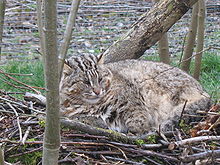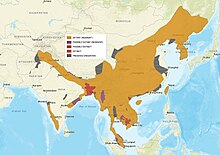| Leopard cat | |
|---|---|

| |
| Indian leopard cat (P. b. bengalensis) | |

| |
| Amur leopard cat (P. b. euptilura) both at the Parc des Félins | |
| Scientific classification | |
| Domain: | Eukaryota |
| Kingdom: | Animalia |
| Phylum: | Chordata |
| Class: | Mammalia |
| Order: | Carnivora |
| Suborder: | Feliformia |
| Family: | Felidae |
| Subfamily: | Felinae |
| Genus: | Prionailurus |
| Species: | P. bengalensis
|
| Binomial name | |
| Prionailurus bengalensis (Kerr, 1792)
| |
| Subspecies | |
| |

| |
| Distribution of the leopard cat, 2022[1] | |
The leopard cat (Prionailurus bengalensis) is a small wild cat native to continental South, Southeast, and East Asia. Since 2002 it has been listed as Least Concern on the IUCN Red List as it is widely distributed although threatened by habitat loss and hunting in parts of its range.[1]
Historically, the leopard cat of continental Asia was considered the same species as the Sunda leopard cat. As of 2017, the latter is recognised as a distinct species, with the taxonomic name Prionailurus javanensis.[2]
Leopard cat subspecies differ widely in fur colour, tail length, skull shape and size of carnassials.[3] Archaeological evidence indicates that the leopard cat was the first cat species domesticated in Neolithic China about 5,000 years ago in Shaanxi and Henan Provinces.[4]
- ^ a b c d Ghimirey, Y.; Petersen, W.; Jahed, N.; Akash, M.; Lynam, A.J.; Kun, S.; Din, J.; Nawaz, M.A.; Singh, P.; Dhendup, T.; Marcus, C.; Gray, T.N.E. & Phyoe Kyaw, P. (2022). "Prionailurus bengalensis". IUCN Red List of Threatened Species. 2022: e.T18146A212958253. doi:10.2305/IUCN.UK.2022-1.RLTS.T18146A212958253.en. Retrieved 22 July 2022.
- ^ Kitchener, A. C.; Breitenmoser-Würsten, C.; Eizirik, E.; Gentry, A.; Werdelin, L.; Wilting, A.; Yamaguchi, N.; Abramov, A. V.; Christiansen, P.; Driscoll, C.; Duckworth, J. W.; Johnson, W.; Luo, S.-J.; Meijaard, E.; O’Donoghue, P.; Sanderson, J.; Seymour, K.; Bruford, M.; Groves, C.; Hoffmann, M.; Nowell, K.; Timmons, Z.; Tobe, S. (2017). "A revised taxonomy of the Felidae: The final report of the Cat Classification Task Force of the IUCN Cat Specialist Group" (PDF). Cat News. Special Issue 11: 26–29.
- ^ Groves, C. P. (1997). "Leopard-cats, Prionailurus bengalensis (Carnivora: Felidae) from Indonesia and the Philippines, with the description of two new subspecies". Zeitschrift für Säugetierkunde. 62: 330–338.
- ^ Vigne, J.D.; Evin, A.; Cucchi, T.; Dai, L.; Yu, C.; Hu, S.; Soulages, N.; Wang, W.; Sun, Z.; Gao, J.; Dobney, K.; Yuan, J. (2016). "Earliest "Domestic" Cats in China Identified as Leopard Cat (Prionailurus bengalensis)". PLOS ONE. 11 (1): e0147295. Bibcode:2016PLoSO..1147295V. doi:10.1371/journal.pone.0147295. PMC 4723238. PMID 26799955.
Cite error: There are <ref group=note> tags on this page, but the references will not show without a {{reflist|group=note}} template (see the help page).
